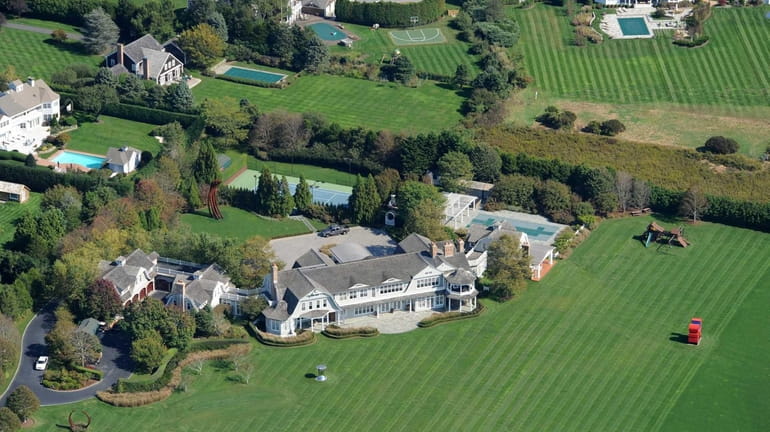Hamptons zoning disputes rise to high-dollar lawsuits

The Bridgehampton estate of Howard Lutnick is located on Halsey Lane. Credit: Hampton Pix / Doug Kuntz
Business titans and celebrities with homes in the Hamptons -- used to getting what they want when they want it -- can create headaches for officials enforcing laws meant to preserve the bucolic scenery.
The most recent example is Howard Lutnick, chief executive of Wall Street's Cantor Fitzgerald financial services firm, who filed two federal lawsuits this year against Southampton Town over the denial of a proposed barn and basketball court on his 41-acre Bridgehampton property.
Lutnick's cases reflect the high stakes in zoning disputes east of the Shinnecock Canal, where real estate values are among the highest in the country.
Southampton and East Hampton towns, and the villages in them, set aside hundreds of thousands of dollars each year for private attorneys to take on some of the big zoning disputes and other legal issues not handled by town attorneys, officials said.
"It's part of the landscape," Southampton Town Attorney Tiffany Scarlato said of fighting lawsuits from wealthy residents whose summer homes dot the shoreline and former farm fields of the South Fork. Her office of six attorneys handles most of the town's land use cases, she said.
"The sheer number of them is fairly high because often the people with land use applications are people of means, and if they don't like the decision, they immediately file a lawsuit," she said. "It keeps us very busy."
Southampton Town budgeted $680,000 this year for outside attorneys, Scarlato said. It also buys insurance that covers some legal fees, she said. She declined to comment on the Lutnick lawsuits other than to say insurance is covering the cost of an outside attorney for those cases.
East Hampton Town has budgeted $375,000 this year for outside attorneys, Supervisor Larry Cantwell said. That covers legal fees for zoning lawsuits, but also labor and other types of cases.
"The bottom line is people want what they want, and the local government and the communities have a broader responsibility," Cantwell said.
Strict land use regulations in the East End towns and villages have been adopted to not only maintain the region's rural feel but also to protect fragile shorelines and wetlands.
"We often describe planning and zoning out here as a full-contact sport," said Robert DeLuca, president of Group for the East End, an organization that advocates for land preservation and other environmental causes. "The very resources people come here to appreciate also give people a sense that, because you paid a certain amount for something, you're allowed to do a lot with it."
A history of lawsuits
High-profile zoning fights have become part of East End lore.
Barry Trupin, a financier and developer, spent much of the 1980s mired in a legal battle with Southampton Village as he tried to transform a mansion into a fantasy castle full of medieval armor and a shark tank.
Ira Rennert's neighbors sued Southampton Town in the 1990s when the billionaire industrialist started building his 100,000-square-foot residential complex along the ocean.
And East Hampton Village was embroiled in a 1990s legal dispute between Martha Stewart and her neighbor, developer Harry Macklowe, over landscaping and a fence.
More recently, the East Hampton Town trustees have fought lawsuits by oceanfront homeowners who want to assert their right to exclusive use of a beach in Napeague.
"It's true whenever you have a very valuable property, you have a successful property owner and you have an attorney who is willing to bring on the lawsuit," said Anthony Tohill, the lawyer who represented Rennert and now works for several villages. "It's happened here for years."
Seeking amenities
Lutnick filed a $20 million lawsuit against Southampton Town in February after the planning board blocked his application to build an 11,250-square-foot steel barn on his property. The board said in its decision that Lutnick did not need a barn that size to maintain an orchard on his property and approved a much smaller barn.
He filed a separate $36 million lawsuit on April 11 after the town zoning board of appeals last year denied his application to build a 54-by-88-foot outdoor basketball court. That body said the proposed court was located outside a "building envelope" the town created on the property to keep part of it off-limits to construction.
The investment banker bought the property for $15 million in 2003, according to court documents. He has already built a baseball diamond and installed playground equipment.
Lutnick's attorney said Southampton Town law allows for agricultural buildings and some "recreational uses" on the property.
The town crafted an easement governing what could be built on the property when previous owners subdivided it in 1980. The easement was intended to preserve the town's "natural, agricultural and scenic resources," but allows some development, according to a copy.
"Here you have a property owner that doesn't want one thing that wasn't agreed to," said David Neufeld, Lutnick's attorney.
The lawsuits allege the boards' denials were "arbitrary and irrational." They name individual members of the planning board, the zoning board of appeals and an agricultural committee as defendants.
